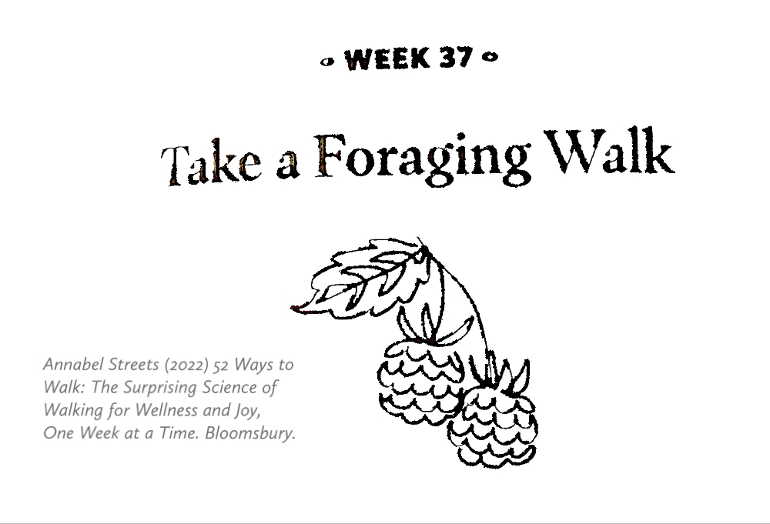It’s Foraging time!!! My favourite ingredient in my smoothies ripens in this foraging season, so this challenge comes at the perfect time!
★★★ Take some containers and go for a foraging walk★★★
And I have something special prepared, for those who like walking or jeffing (run walking) with music or podcasts!
I have a Spotify playlist ready, foraging themed, which hopefully gets you in the mood. A free subscription (with adverts) should get you to the list at
open.spotify.com/playlist/7...
But I also have piloted a podcast-music show ideal, for jeffing and which mixes words with tracks. Not perfect but a little bit of motivating fun, perhaps.
For those of you run-walking (jeffing), one runs whilst listening to the songs and I chat on the podcast whilst we walk together. So if you’re up for listening to my 1 minute rambles between songs, this might be fun to try. Just be aware that unless you have a paid subscription with Spotify, you will only hear the first 50-60 seconds of every song.
So my advice to those of you with only free subscriptions is to listen whilst walking (and/or running) to the whole show once (with only shorter song preview), but then head to the above linked Spotify list and enjoy lots of foraging-themed songs.
It was fun putting it together, but it might not be everyone’s thing.
Link to the Spotify music podcast show is here open.spotify.com/episode/7g...
So wether with music or not, this month’s challenge is for us to get out there, and
★★★ Take some containers and go for a foraging walk★★★
My first batches are already in the freezer! Hubby, son, and I tend to collect blackberries yearly ever since my little family moved into our current house situated at the edge of fields, small woodlands, sandy paths left from a seashore millions of years ago and farmhouses that appear on hillocks in the middle of fields full of cows or horses.
Specifically hubby manages to find the best blackberry patches on his long walks. I do collect, but I have to admit, I prioritise my runs. My walks don’t reach as far as hubbies. But we went this weekend on a blackberry foraging walk!
But my weakness is definitely wild garlic, and that stops any of my runs to pick a few leaves for my own immediate culinary pleasure. And there is a large patch just on my trusty, old route I used for C25k and one I still run regularly.
Although it’s in danger of getting taken over by the invasive Himalayan Balsam, although we (that is hubby) is fighting it back. More to that later.
So it’s hubby who still finds the major share of blackberries and, unlike me, manages to bring his finds home. We tend to freeze foraged blackberries immediately. We’ve managed to collect so many that often they last at least 9 to 10 months. They make their way into smoothies, mug crumbles, and apple crumble pies (all gluten-free).
But I more often forage closer to home around the wild patches in our garden and am known to sneak dandelion leaves into our salads or wild garlic into our scrambled eggs or pick leaves from the fat hen family of plants in place of braised spinach.
So I was keen to re-read this little chapter of Annabel Street’s Book, all about taking foraging walks, and it doesn’t disappoint.
She talks about some key books: Patience Gray’s Honey from a Weed, Roger Phillips’ Wild Food, the classic Richard Mabey’s Food for Free and Geoff Dann’s Edible Mushrooms, John Wright’s The Forager Calendar and Fiona Houston’s Seaweed and Eat it.
Of these, I only have Mabey’s Food for Free, but I have spent many times comparing the gorgeous sketches with plants from our forages.
I have foraged elderflowers, cobnuts, edible chestnuts, different leaves and berries, elderflowers, and I dream of finding truffles. But there are also some plants I have not had enough courage to try, including nettles, rose-hips or mushrooms.
But it’s worth considering foraging, and Annabel Street emphasises how healthy foraged foods tended to be, and she praises specifically the good old blackberry. It’s packed with antioxidants, vitamins C, A and K. Studies in rats suggest they help balance and coordination.
Foraging has distinct seasons for specific plants. She writes:
- In April she collects dandelion leaves and nettle tops.
- May and June brings wild garlic and elderflowers.
- August and September brings loads, blackberries, crabapples, sloes, rosehips, damsons.
- And September and October also brings truffles, mushrooms and nuts.
And for some guiding tips, she has the following wisdoms:
- First her words of warning: Never eat anything you’re unsure of
- But there are an increasing number of guided foraging walks
- Don’t pick more than you need
- Don’t dig up plants
- The law suggests as long as you pick for personal consumption, and not for commercial use, it’s all good
- Avoid areas that might be polluted
- Wash your weeds well
- Don’t forget to take containers
★★★ Take some containers and go for a foraging walk★★★
Readings from
Annabel Street (2021): 52 ways to walk.
The surprising signs of walking for wellness and joy, one week at a time. Chapter 37 : Take a Foraging Walk
And for your reference, our prior THEMED CHALLENGES ARE:
★ January Challenge - Walk in the Cold healthunlocked.com/active10...
★ February Challenge - Take a 12-min walk healthunlocked.com/active10...
★ March Challenge - Take a City Smell Walk healthunlocked.com/active10...
★ April Challenge -Walk with your Ears healthunlocked.com/active10...
★ May Challenge - Follow a River healthunlocked.com/active10...
★ June Challenge - Walk with a Map healthunlocked.com/active10...
★ July Challenge - Sing as you Stride healthunlocked.com/active10...
★ August Challenge - walk like a nomad and breathe in rhythm to your stride healthunlocked.com/active10...
★ September Challenge - Take a Foraging Walk
